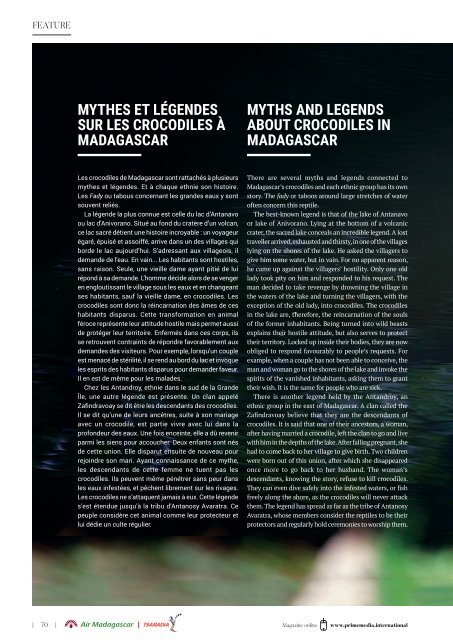Prime Magazine Madagascar July 2020
Prime Magazine Air Madagascar In-flight Magazine
Prime Magazine Air Madagascar In-flight Magazine
You also want an ePaper? Increase the reach of your titles
YUMPU automatically turns print PDFs into web optimized ePapers that Google loves.
FEATURE<br />
MYTHES ET LÉGENDES<br />
SUR LES CROCODILES À<br />
MADAGASCAR<br />
MYTHS AND LEGENDS<br />
ABOUT CROCODILES IN<br />
MADAGASCAR<br />
Les crocodiles de <strong>Madagascar</strong> sont rattachés à plusieurs<br />
mythes et légendes. Et à chaque ethnie son histoire.<br />
Les Fady ou tabous concernant les grandes eaux y sont<br />
souvent reliés.<br />
La légende la plus connue est celle du lac d’Antanavo<br />
ou lac d’Anivorano. Situé au fond du cratère d’un volcan,<br />
ce lac sacré détient une histoire incroyable : un voyageur<br />
égaré, épuisé et assoiffé, arrive dans un des villages qui<br />
borde le lac aujourd’hui. S’adressant aux villageois, il<br />
demande de l'eau. En vain... Les habitants sont hostiles,<br />
sans raison. Seule, une vieille dame ayant pitié de lui<br />
répond à sa demande. L’homme décide alors de se venger<br />
en engloutissant le village sous les eaux et en changeant<br />
ses habitants, sauf la vieille dame, en crocodiles. Les<br />
crocodiles sont donc la réincarnation des âmes de ces<br />
habitants disparus. Cette transformation en animal<br />
féroce représente leur attitude hostile mais permet aussi<br />
de protéger leur territoire. Enfermés dans ces corps, ils<br />
se retrouvent contraints de répondre favorablement aux<br />
demandes des visiteurs. Pour exemple, lorsqu'un couple<br />
est menacé de stérilité, il se rend au bord du lac et invoque<br />
les esprits des habitants disparus pour demander faveur.<br />
Il en est de même pour les malades.<br />
Chez les Antandroy, ethnie dans le sud de la Grande<br />
Île, une autre légende est présente. Un clan appelé<br />
Zafindravoay se dit être les descendants des crocodiles.<br />
Il se dit qu’une de leurs ancêtres, suite à son mariage<br />
avec un crocodile, est partie vivre avec lui dans la<br />
profondeur des eaux. Une fois enceinte, elle a dû revenir<br />
parmi les siens pour accoucher. Deux enfants sont nés<br />
de cette union. Elle disparut ensuite de nouveau pour<br />
rejoindre son mari. Ayant connaissance de ce mythe,<br />
les descendants de cette femme ne tuent pas les<br />
crocodiles. Ils peuvent même pénétrer sans peur dans<br />
les eaux infestées, et pêchent librement sur les rivages.<br />
Les crocodiles ne s’attaquent jamais à eux. Cette légende<br />
s’est étendue jusqu’à la tribu d’Antanosy Avaratra. Ce<br />
peuple considère cet animal comme leur protecteur et<br />
lui dédie un culte régulier.<br />
There are several myths and legends connected to<br />
<strong>Madagascar</strong>’s crocodiles and each ethnic group has its own<br />
story. The fady or taboos around large stretches of water<br />
often concern this reptile.<br />
The best-known legend is that of the lake of Antanavo<br />
or lake of Anivorano. Lying at the bottom of a volcanic<br />
crater, the sacred lake conceals an incredible legend. A lost<br />
traveller arrived, exhausted and thirsty, in one of the villages<br />
lying on the shores of the lake. He asked the villagers to<br />
give him some water, but in vain. For no apparent reason,<br />
he came up against the villagers’ hostility. Only one old<br />
lady took pity on him and responded to his request. The<br />
man decided to take revenge by drowning the village in<br />
the waters of the lake and turning the villagers, with the<br />
exception of the old lady, into crocodiles. The crocodiles<br />
in the lake are, therefore, the reincarnation of the souls<br />
of the former inhabitants. Being turned into wild beasts<br />
explains their hostile attitude, but also serves to protect<br />
their territory. Locked up inside their bodies, they are now<br />
obliged to respond favourably to people’s requests. For<br />
example, when a couple has not been able to conceive, the<br />
man and woman go to the shores of the lake and invoke the<br />
spirits of the vanished inhabitants, asking them to grant<br />
their wish. It is the same for people who are sick.<br />
There is another legend held by the Antandroy, an<br />
ethnic group in the east of <strong>Madagascar</strong>. A clan called the<br />
Zafindravoay believe that they are the descendants of<br />
crocodiles. It is said that one of their ancestors, a woman,<br />
after having married a crocodile, left the clan to go and live<br />
with him in the depths of the lake. After falling pregnant, she<br />
had to come back to her village to give birth. Two children<br />
were born out of this union, after which she disappeared<br />
once more to go back to her husband. The woman’s<br />
descendants, knowing the story, refuse to kill crocodiles.<br />
They can even dive safely into the infested waters, or fish<br />
freely along the shore, as the crocodiles will never attack<br />
them. The legend has spread as far as the tribe of Antanosy<br />
Avaratra, whose members consider the reptiles to be their<br />
protectors and regularly hold ceremonies to worship them.<br />
| 70 | <strong>Magazine</strong> online www.primemedia.international

















